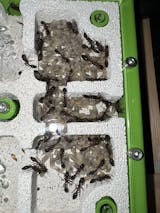Tetraponera rufonigra
General species information: Tetraponera rufonigra is a species from Southeast Asia commonly referred to as the twig ant. They owe their name to their elongated, slender bodies ideal for nesting in, you guessed it, twigs. They pack a powerful sting, they grow fast, they are aggressive, they have the ability to make small jumps, their movements and looks are alien-like, they have beautiful correlation, they are quite sizeable, and their arboreal lifestyle makes them all the more interesting. Shortly put, they are a very interesting species to observe and keep. As long as you can meet their needs, they will prove to be a very nice addition to your collection.
Temperature requirements: Tetraponera rufonigra likes it fairly hot. At temperatures of 27-29 degrees Celsius, their growth will be the fastest, and if you want them to grow a bit slower, you can go as low as 24-25 degrees Celsius.
Humidity: Even though Tetraponera rufonigra is a wood-nesting species in nature, they often nest in rotting wood and twigs. This means you shouldn’t keep them bone dry but actually quite humid. We recommend around 70-80% humidity. It is totally fine if there are some dryer and more humid parts. As long as they have an option for both, it will be fine.
Nesting recommendations: Tetraponera rufonigra can be kept in a range of different nests. Please don’t keep them in nests entirely made out of wood, however, as they can chew through if given enough time. Another reason bare wood is not optimal for them is that, as mentioned, they do appreciate a decent humidity gradient. They do best in test tubes (cheap tubs and tubes set up), acrylic nests, 3D printed mesh nests, and Ytong nests.
Important note: Always make sure to have a plastic, 3D-printed, or acrylic layer around your nests with this species, as they can chew through most materials like wood, ytong, plaster and have been known to be able to bite through hard acrylic if it had preexisting cracks. Also, make sure to use a generous anti-escape barrier when handling these ants.
Setup recommendation: usually we don’t include this bit in our information page, but the mieren machinist (on Instagram), one of our longtime customers, has a beautiful colony of Tetraponera rufonigra he purchased from us. He has given them an outworld that plays right into their arboreal habits modeled after our advice; it is very easy to recreate and will make this species even more enjoyable. Make sure to check his page out for inspiration.
Diet: Tetraponera rufonigra isn’t a fussy eater at all. They like their protein, and they like their sugars. They will virtually accept any feeder insect; in the beginning, give them freshly killed insects, and later on, you can feed them life prey as long as the insect is small enough for the ants to take on. As for sugars, you can feed them fruits, honey, homemade sugar water (be careful it doesn’t ferment and kill your ants), or any store bought sugar source as long as the source is trustworthy (we recommend sunburst ant nectar from Byformica, sugar snaps from Antantics, and formipure from Wakooshi).
Castes: Tetraponera rufonigra has workers, queens, males and females. Workers may vary slightly in size, especially in young colonies where brood isn’t always fed equally, but Tetraponera rufonigra doesn’t have polymorphism.
Worker size: 8–12mm
Queen size: 10-14mm
Colony format: Tetraponera rufonigra is a polygynous species. This means that they can have multiple mated egg laying queens in their nest. Of course there are a bunch of workers that perform duties too. In the wild, colonies might have unmated queens that act like workers, and depending on the season, males can be present too. This species is semi-claustral, meaning they need to be fed whilst raising their first batch of workers. They can be found with multiple queens. We, however, will never sell single queens, as they are tricky to find, so we won’t need to elaborate further on this.
Max colony size: With one queen, colonies of this species can reach a worker count of around 1000–2000 workers; with multiple queens, this can however be higher.
Development: The time it takes for this species to go from egg to worker is quite long, but due to their high productivity in terms of egg laying, this species will still develop rapidly. In extreme cases, you can expect 500-1000 workers in their first year of growth.
Defense/attack: Tetraponera rufonigra has a very strong grip and an intense sting. They’re also very flexible, agile, and fast. They will use all of these abilities to their maximum potential to make potential attackers or prey items nearly impossible to escape.
Danger level: They have a very powerful sting, as mentioned. If you happen to be allergic to this sting, it can result in a dangerous situation. Always handle this species with soft-touch tweezers like the ones we sell on our website, and be very careful in handling them. If you know you’re allergic, always have an epipen in close proximity and keep these ants away from younger children. We don’t recommend this species for children younger than 14 years.
Diapause/hibernation: This species doesn’t have a rest period and will grow year around.
Difficulty: They aren’t the easiest species, but that is mainly because they’re escape artists and can be overly aggressive. They aren’t fussy with food, and if their needs are met, they will be a reliably enjoyable species to keep without too many difficulties.
On a difficulty scale from 1 to 5 (5 being the most difficult), we rate this species a 3.5 based on personal experience and customer feedback.








